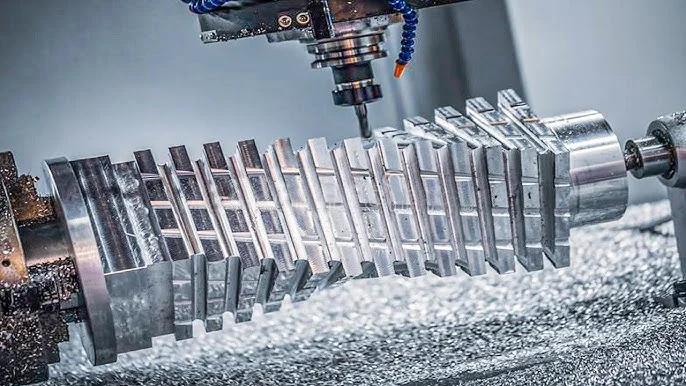CNC machining in aluminum is another notable manufacturing process that is gaining wide acceptance in production. This method involves precise and computer-controlled machining of body and structural parts out of aluminum, a flexible material. The pros of CNC machining in aluminum will also be presented in this article, as well as, its characteristics, suitable grades, and recommendations on how to avoid potential problems in production.
What Are the Basic Features of Aluminium CNC Machined Parts?
The several fundamental characteristics that make it an excellent choice for CNC machining in aluminum:
- Lightweight: Lightweight makes aluminum suitable for many applications where weight is critical for an application such as in aerospace industries or the car industry.
- Corrosion Resistance: Indeed, aluminum oxide itself forms a layer over the aluminum surface which makes it resist corrosion, making the parts made of this metal last for a longer period.
- Excellent Machinability: Aluminum is also very easy to work with and can be molded or cut into almost any kind of design easily. This property helps to achieve high precision in CNC machining.
- Thermal Conductivity: Besides, Aluminum is a quite good conductor of heat, so it is useful in several applications that need heat control.
- Recyclability: Aluminum can be recycled to its form one thousand and still retain its properties, thus an ecological material in manufacturing.
Aluminum Grades You Can Use for Your CNC Project
During CNC machining in aluminum, it’s important to select the appropriate grade of material. Here are some common aluminum grades used in CNC projects:
- 6061 Aluminum: This is one of the most widely used aluminum alloys known to man or at the markets up to the recent past. Overall, it possesses good mechanical properties and demonstrates excellent corrosion resistance. This is common in structural engineering and manufacture of automobile parts.
- 6063 Aluminum: This grade has very good extrusion characteristics to allow it to be used in any architectural application such as manufacture of window and doors. It has a very smooth surface with no surface roughness and has moderate corrosion protection.
- 7075 Aluminum: This is a high strength alloy that can be applied in aerospace products and services. In its mechanical properties it has high fatigue durability and can be used for parts that are subjected to heavy loads.
- 2024 Aluminum: Originally manufactured for aircraft structures, 2024 aluminium alloy features high strength to weight performance. It exhibits moderate machinability; nevertheless, it does not have as good corrosion immunity as the other grades.
- 5052 Aluminum: This kind of grade is fairly good in welding and is also fine when used in corrosive environments. This is common especially in marine and particularly in fuel tank purposes.
Hence, the choice of the right aluminum grade depends on the application of the finished aluminum product in relation to strength, corrosion properties, and machinability.
Applications of Aluminum Components & Parts in CNC Machining
Aluminum components made through CNC machining have several practical uses:
- Aerospace Parts: Lightweight yet extremely durable, aluminum is best suited for use in aircraft frames and other components which leads to increased aircraft efficiency.
- Automotive Parts: A significant part of parts for cars such as engine blocks and wheels are created from aluminum as it decreases their weight and benefits performance.
- Consumer Electronics: The basic bodyworks of most portable gadgets such as laptops, smartphones, and the like mainly utilize aluminum due to its lightweight and good looks.
- Industrial Equipment: It is quite common to find that many machines and tools, which are manufactured to have durability, incorporate aluminum parts due to their strength and corrosion resistance that lasts long.
- Marine Applications: This is true as aluminum normally resists corrosion and therefore is used in boats and other marine devices.
To learn more about CNC machining in aluminum services please refer to 3ERP a CNC machining company with various services such as prototyping and mass production services.
How to Avoid Deformation of CNC Aluminum Parts
Aluminum parts deformation during machining can be a very serious problem. Here are some tips to avoid this problem:
Proper Tool Selection
Choose and apply the appropriate tools needed to work on aluminum. Since friction and heat produce damage to the workpiece, sharp clear edge tools minimize these factors.
Optimal Cutting Speed
The cutting speed of the aluminum will need to be altered depending on the grade of the material. When cutting speeds are too high, tools become hot and may lead to overheating, while speeds that are too low will increase tool wear.
Adequate Cooling
While machining, use coolant to reduce the amount of heat produced. This reduces warping and keeps it accurate, this section is still under construction though.
Secure Fixturin
For this case, it is very important to make sure that the aluminum piece is well fixed in the machine. Some parts tend to deform during cutting and this is most likely to occur with loose parts.
Regular Inspection
During the machining process, it is also important to inspect the parts for any signs of deformation to correct the issue before the final stages of production.
Importance of Applying Aluminum during CNC Machining
Using aluminum in the CNC machining process offers numerous benefits:
- Cost-Effective: Aluminum is cheaper than other metals and thus the manufacturers are in a position to cut down the total manufacturing cost.
- Quick Turnaround: Besides, as we already hinted at the fact that aluminum can be easily machined out of all the known materials, at times aluminum parts can be made in relatively less time than the parts which are made out of very hard materials.
- Versatility: Aluminum is highly malleable, which means that this material can be bent into a number of forms and this means that it can be used in a number of ways.
- Lightweight Solutions: As for operations, the low density of aluminum sections are useful for the project for instance in airplane and automobile manufacture.
- High Strength: Aluminum is generally a light weight material but it is very strong and hence available for use in structural products.
Summing Up
CNC machining in aluminum is an effective manufacturing process that has some advantages. Its low density, corrosion resistance, and various types of aluminum make it a material suitable for many applications. By employing such practices, the manufacturer can produce high-quality components that would be demanded in their various industries.







